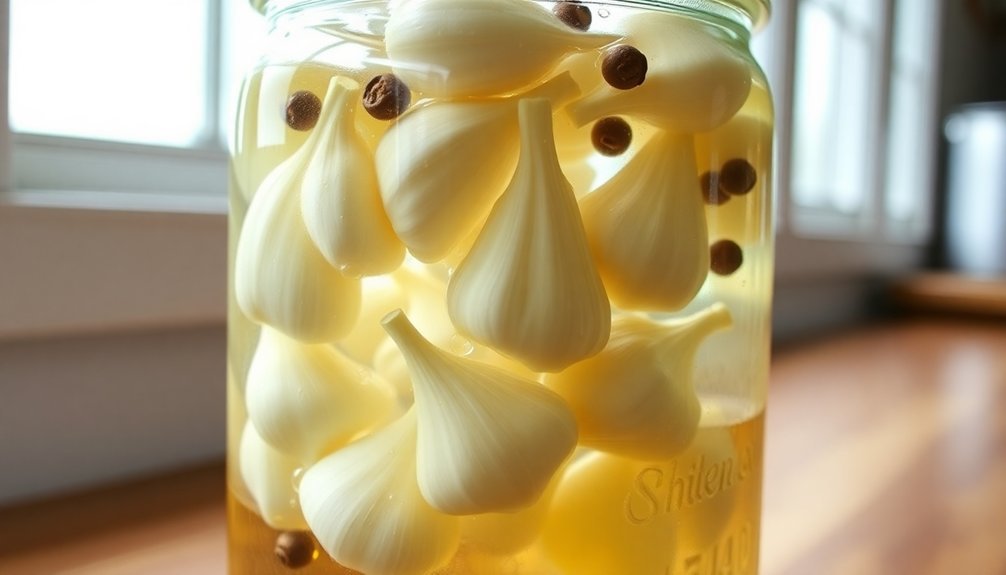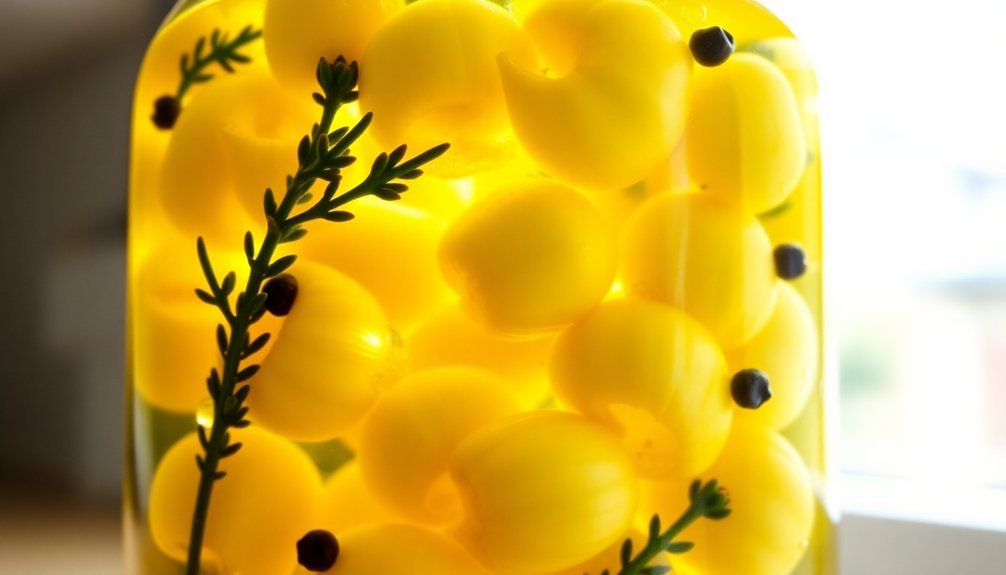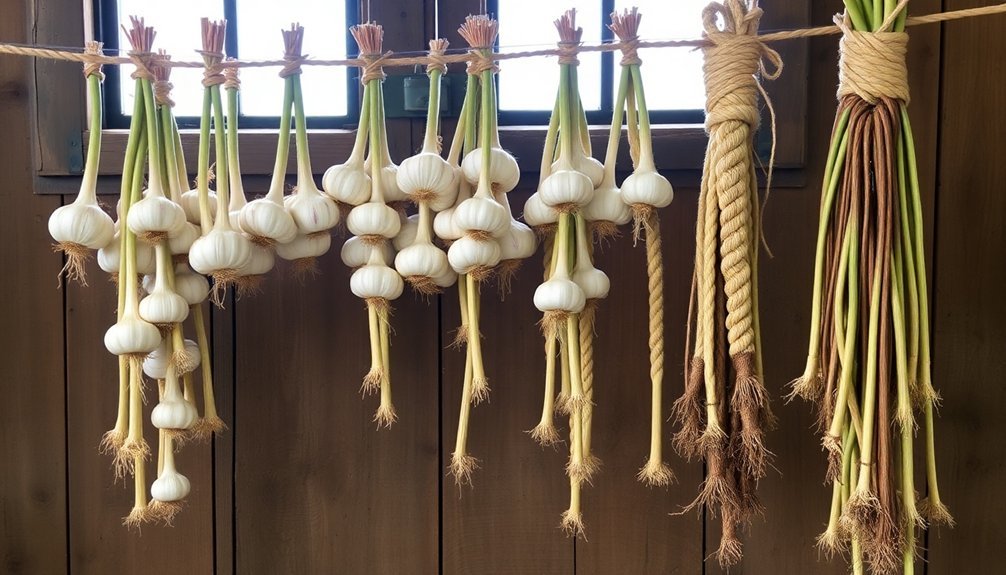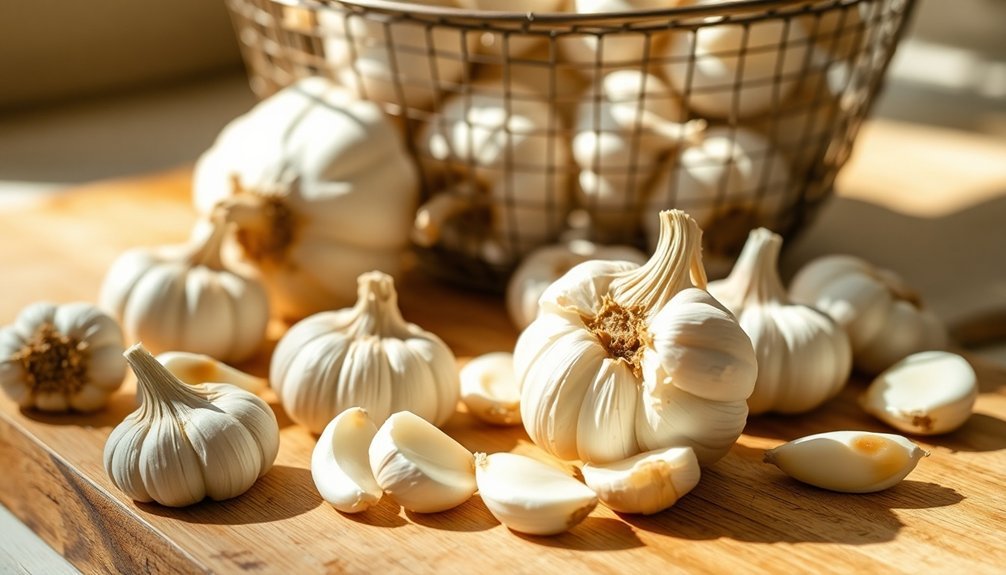Five proven methods will help you preserve garlic's distinctive flavor for months. You can pickle whole cloves in apple cider vinegar for 4-6 months of storage, or freeze peeled cloves in airtight bags for up to six months. Oil-based preservation works well when you follow proper safety protocols and store in the refrigerator. Dehydrating sliced garlic creates a shelf-stable option that maintains flavor and nutrition, while proper curing of fresh bulbs develops better taste and extends storage life. These preservation techniques offer varying benefits – from convenience to longevity – and each method brings its own unique advantages to your kitchen.
Preserving Garlic With Vinegar Solution

Three simple ingredients – garlic cloves, vinegar, and glass jars – are all you'll need to preserve garlic in a vinegar solution. Choose whole, peeled garlic cloves and raw apple cider vinegar for best results, though you can also use white wine vinegar or homemade fruit vinegar alternatives.
Start by separating and peeling the garlic cloves without cutting or crushing them to maintain their allicin content. Place the cloves in a clean glass jar, leaving an inch of space at the top, and pour your chosen vinegar until it completely covers the garlic. You might need a glass weight to keep the cloves submerged. Don't be alarmed if you notice your garlic cloves turning slightly green during pickling.
You'll have two storage options: let the mixture sit at room temperature for 1-2 weeks before moving it to cold storage, or place it directly in the refrigerator to prevent mold growth.
The acidic environment will keep your preserved garlic safe for 4-6 months when refrigerated. You can use the garlic-vinegar mixture in salad dressings, condiments, or any dish that calls for garlic.
This preservation method not only maintains the garlic's health benefits but also reduces its harsh effects while supporting gut health.
Freezer Storage for Fresh Garlic
A reliable freezer storage method can extend your fresh garlic's life for up to six months while preserving its distinctive flavor. Before freezing, you'll need to separate the cloves, remove their papery skins, trim the root ends, and clean off any imperfections. Make sure to dry the cloves thoroughly after peeling to prevent excess moisture. Adding coarse salt while chopping can help soften the garlic and enhance its flavor.
You've got several effective freezing options to choose from. Store whole cloves in airtight freezer bags, or chop and freeze the garlic in ice cube trays. For added versatility, you can puree your garlic with olive oil before freezing. Silicone ice trays with lids work particularly well for storing chopped garlic portions.
Select your storage containers carefully – ziplock bags offer easy access and flat storage, while freezer-safe Tupperware provides sturdy protection. Don't forget to label your containers with the freeze date. For ideal flavor, use your frozen garlic within three months, though it'll stay good for up to six months.
When you're ready to use your frozen garlic, let it sit at room temperature for about five minutes. You'll find it doesn't freeze completely solid, making it easy to crush, slice, or chop as needed.
Oil-Based Garlic Preservation Methods

Preserving garlic in oil offers a convenient way to keep your fresh cloves readily available, but you'll need to follow strict safety protocols to prevent harmful bacteria growth. The most critical safety measure is refrigeration, as room-temperature storage can create ideal conditions for botulism toxin production. Add citric acid to your garlic oil preparation to help prevent botulism growth.
To properly preserve your garlic in oil, start with a clean, sterilized mason jar. Peel your garlic cloves carefully, keeping them whole and uncut to maintain their nutritional value. Submerge the cloves completely in high-quality olive oil or avocado oil, making sure no parts are exposed to air.
You'll want to label your container with the date, as storage time shouldn't exceed three months, even in the refrigerator.
While storing garlic in oil, you might notice the cloves turning blue or green – don't worry, this is just an enzymatic reaction that won't affect taste or safety. You can use both the preserved garlic and the infused oil in your cooking, from salad dressings to pasta dishes.
Remember that home preservation can't replicate commercial acidification processes, so always prioritize proper refrigeration and careful handling.
Dehydrating Garlic for Storage
Extending your garlic's shelf life through dehydration offers an effective long-term storage solution that maintains flavor and nutritional value. You'll need a food dehydrator, oven, or air fryer to begin the process, setting temperatures between 105°F and 125°F for ideal results.
Start by peeling and slicing your garlic into thin, wide pieces for even drying. Space them properly on dehydrator trays or baking sheets to guarantee good air circulation. The process typically takes 6 to 12 hours, and you'll know your garlic is ready when it snaps cleanly and feels brittle.
Store your dehydrated garlic in airtight glass mason jars with tight-fitting lids. You can enhance storage life by using a vacuum sealer attachment to remove excess air. Keep the jars in a cool, dark place, where they'll last up to a year, or store them in the freezer for indefinite preservation.
For quality control, condition your dried garlic by checking for moisture during the first 24 hours of storage. If you're making garlic powder, only grind what you'll use within 2-6 months, as whole dehydrated pieces maintain their quality longer.
Watch for signs of spoilage like moisture or mold, and always label your containers with drying dates.
Curing Fresh Garlic Bulbs

Throughout the curing process, fresh garlic bulbs develop their distinctive flavors and achieve ideal storage potential. To cure your garlic properly, you'll need to create the right environment with temperatures between 70-80°F, moderate humidity, and good airflow using fans.
Start by harvesting your garlic when the tops are still partially green. Trim the leaves, leaving 6-9 inches of stem, and remove the lowest green leaf to prevent moisture buildup. Don't wash the bulbs; instead, gently brush off excess dirt and trim the roots.
You've got several methods for curing: hang bulbs in bundles, use vertical netting, lay them horizontally on racks, or stand hardneck varieties upright. Whatever method you choose, guarantee you're providing proper air circulation in a dark, dry space like a garage or shed.
The curing process typically takes three weeks. You'll know it's complete when the stem's interior has dried and the paper wrappers feel brittle.
After curing, remove the fans and trim the stems to about 5 inches. Check your garlic for any signs of mold or cosmetic issues that might affect storage quality.
Frequently Asked Questions
Can Damaged or Sprouted Garlic Cloves Still Be Preserved?
Yes, you can preserve damaged or sprouted garlic by freezing it whole or pureed, storing it in vinegar or wine, or dehydrating it. You'll need to act quickly and choose the method that suits your needs.
How Do You Remove Garlic Odors From Containers After Storage?
You can remove garlic odors from containers using four effective methods: make a baking soda paste, soak in vinegar, stuff with newspaper, or clean with bleach. Let each treatment sit overnight for best results.
What Signs Indicate Preserved Garlic Has Gone Bad?
You'll know preserved garlic's bad if you notice mold growth, unusual discoloration, off-putting odors, or mushy texture. If it's stored in oil, watch for cloudiness and check that it's properly acidified and refrigerated.
Can Preserved Garlic Maintain Its Medicinal Properties During Long-Term Storage?
Yes, you'll maintain garlic's medicinal properties during storage if you keep cloves whole in vinegar and refrigerate them. The allicin stays stable, and you'll preserve its health benefits for up to a year.
Should Different Varieties of Garlic Be Stored Separately?
Yes, you'll want to store different garlic varieties separately since they have varying storage times and needs. Keep your softneck and hardneck garlic apart to monitor their individual conditions and prevent cross-contamination.
In Summary
You've now got several proven methods to keep your garlic fresh and flavorful for months. Whether you're pickling in vinegar, freezing cloves, storing in oil, dehydrating, or curing whole bulbs, you'll never have to waste garlic again. Choose the preservation technique that best fits your cooking style and kitchen setup. With these methods, you'll always have this essential ingredient ready whenever you need it.





Leave a Reply